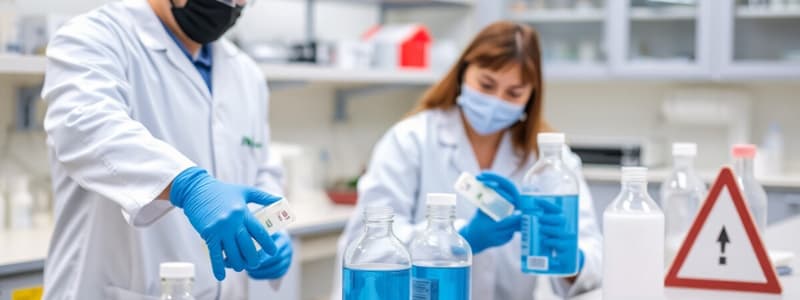Podcast
Questions and Answers
In a laboratory setting, why is it essential to check chemical labels twice before use?
In a laboratory setting, why is it essential to check chemical labels twice before use?
- To confirm that the chemical has not passed its expiration date, regardless of its current state.
- To ensure the container is aesthetically pleasing and properly aligned on the shelf.
- To guarantee the chemical is approved by all members of the research team.
- To prevent errors in identification and understand potential hazards associated with the substance. (correct)
What is the appropriate first action to take if you spill a chemical or break equipment during a lab experiment?
What is the appropriate first action to take if you spill a chemical or break equipment during a lab experiment?
- Consult with lab partners to decide on the best course of action without involving the instructor.
- Immediately notify your instructor for assistance and guidance on proper cleanup and disposal methods. (correct)
- Attempt to clean up the spill or repair the equipment immediately to avoid delaying the experiment.
- Ignore minor spills or breakages and continue with the experiment, addressing larger issues later.
Why is it important to avoid forcing glass tubing into rubber stoppers or pipettes into pipette?ers
Why is it important to avoid forcing glass tubing into rubber stoppers or pipettes into pipette?ers
- Forcing glassware ensures a tighter seal, preventing leaks and improving experimental accuracy.
- The method creates a temporary airtight seal that is stronger than standard connections.
- The practice ensures uniform expansion of glass and rubber when heated.
- Applying excessive force could cause the glass to break, leading to potential injuries from shards. (correct)
When mixing acids with water, what is the correct procedure and why?
When mixing acids with water, what is the correct procedure and why?
Why is it unsafe to leave Bunsen burners or any other heat source unattended while in use during a lab experiment?
Why is it unsafe to leave Bunsen burners or any other heat source unattended while in use during a lab experiment?
Why are organic solvents never disposed of down the sink in a laboratory setting?
Why are organic solvents never disposed of down the sink in a laboratory setting?
What should you do if you need to smell a chemical in the lab, as instructed?
What should you do if you need to smell a chemical in the lab, as instructed?
Why should you check all waste labels twice before adding your waste to a waste container?
Why should you check all waste labels twice before adding your waste to a waste container?
Flashcards
Supervised Lab Work
Supervised Lab Work
Working in the lab is only permitted when your instructor is present to ensure safety and proper guidance.
Safety Goggles
Safety Goggles
Safety goggles must be worn during lab sessions involving chemicals or hazardous materials to protect your eyes.
Lab Attire
Lab Attire
Appropriate clothing (no sandals) and closed-toe shoes are required in the lab to protect against spills and hazards.
No Consumption in Lab
No Consumption in Lab
Signup and view all the flashcards
Double-Check Labels
Double-Check Labels
Signup and view all the flashcards
Reporting Incidents
Reporting Incidents
Signup and view all the flashcards
Test Tube Direction
Test Tube Direction
Signup and view all the flashcards
Acid to Water
Acid to Water
Signup and view all the flashcards
Study Notes
- Laboratory work is only allowed when an instructor is present.
Safety Goggles and Attire
- Safety goggles are required during lab sessions involving chemicals or hazardous materials.
- Appropriate clothing and closed-toe shoes must be worn in the lab; sandals are not allowed.
- Long hair must be tied back.
Conduct in the Lab
- Eating, drinking, chewing gum, storing food, or applying cosmetics are prohibited in the lab.
- Never taste chemicals.
- Smell chemicals cautiously by wafting vapors when instructed.
Emergency Preparedness
- Know the locations of the eyewash station, shower, spill cleanup materials, and emergency exits.
Chemical Handling
- Check chemical labels twice before use.
- Familiarize yourself with the hazards of each chemical.
- Material Safety Data Sheets (MSDS) are available for chemical property information.
Glassware
- Do not force glass tubing into rubber stoppers or pipets into pipetters.
- Examine glassware before use; do not use chipped, cracked, or dirty glassware.
Spills and Accidents
- Report all spills and equipment breakage to the instructor immediately.
- Sweep up broken glass and dispose of it in the designated broken glass box.
- Notify the instructor immediately if you are injured or if any accident or fire occurs.
Heating and Mixing Chemicals
- Point test tubes away from people when mixing or heating chemicals.
- Never leave heat sources unattended.
- Avoid using spark or flame sources near flammable liquids. Most organic solvents are flammable.
- Always add acid to water when mixing.
Chemical Disposal
- Dispose of chemicals as directed by the instructor.
- Do not put solid materials in sinks or liquid wastes in wastebaskets.
- Check waste labels twice before adding waste to a container.
- Organic solvents are never to be disposed of down the sink; use designated waste containers.
Fume Hoods
- Use fume hoods when working with volatile or poisonous substances; do not put your head inside.
Hot Glassware
- Do not immerse hot glassware in cold water.
- Place hot glassware on insulating pads, not directly on countertops.
Cleanliness
- Keep the lab area and supplies clean.
- Store all equipment in the proper locations.
- Wipe down the work area before leaving.
- Ensure the lab looks the same as when you started.
Studying That Suits You
Use AI to generate personalized quizzes and flashcards to suit your learning preferences.




